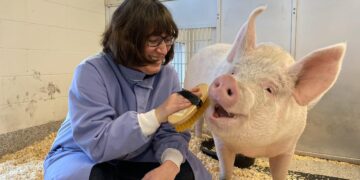Table of Contents
The Day I Failed a Dog Named Charlie
As a veterinary behaviorist, I’ve dedicated my life to understanding the intricate language of animals.
For years, I believed that with enough expertise, enough checklists, and enough good intentions, I could engineer the perfect match between a shelter dog and a family.
I was confident, methodical, and, as I would learn, profoundly wrong.
My moment of reckoning came in the form of a handsome, 70-pound Labrador mix named Charlie.
On paper, he was the ideal candidate for adoption.
In his kennel, he was calm and quiet, offering a gentle tail wag to passersby.
The family I had lined up was equally perfect—experienced, patient, with a sprawling, fenced-in yard and a deep commitment to giving a rescue dog a second chance.
We followed every rule in the book.
We discussed their lifestyle, reviewed Charlie’s limited history, and conducted multiple meet-and-greets.
The adoption felt like a textbook triumph.
Three weeks later, the phone call came.
The family was heartbroken, but Charlie was coming back.
The serene dog from the shelter had transformed into a bundle of raw anxiety.
When left alone, he had chewed through a doorframe and clawed his way through drywall.
The quiet companion they had envisioned was, in reality, suffering from severe separation anxiety that none of us had seen coming.1
Walking through their home, seeing the damage and the family’s defeated faces, I felt a crushing sense of failure.
It wasn’t just a professional miss; it was personal.
I had failed Charlie, I had failed that wonderful family, and my entire framework of knowledge felt like a house of cards.
This wasn’t a case of a “bad dog” or “bad owners.” This was a systemic failure.
It forced me to confront a painful question: If following all the best practices could lead to such a disastrous outcome, what were we all getting wrong about dog adoption?
Part I: The Anatomy of a Failed Adoption: Why Good Intentions Aren’t Enough
My experience with Charlie wasn’t an anomaly.
It was a symptom of a deeply flawed approach to adoption, one that sets up both dogs and humans for failure.
The core of the problem lies in a series of invisible traps woven into the very fabric of how we think about bringing a rescue dog home.
The Great Expectation Gap
The single greatest predictor of a failed adoption is the chasm between our romanticized expectations of a dog and the complex reality of who they are.
Data consistently shows that a significant number of adoptions unravel within the first few months, with some studies indicating a rate as high as 22%.3
The reasons cited often sound like a laundry list of behavioral issues: destructive chewing, incessant barking, house-soiling, and hyperactivity.1
But here is the critical discovery: the problem isn’t the behavior itself.
It’s the expectation that it shouldn’t be happening.
Research has revealed a startling paradox: owners who return their dogs often have higher and more rigid expectations for behavior and the human-dog bond than those who don’t.3
They envision an instant connection and a seamless transition, a “perfect dog” that slots neatly into their lives.
When the reality of a stressed, confused animal emerges, the dream shatters.
This is compounded by a fundamental misunderstanding of the canine adjustment timeline.
A large percentage of returns for so-called “nuisance behaviors” happen shockingly fast—37% within the first 7 days.4
This is precisely when a dog is at its most disoriented.
The widely respected “3-3-3 Rule” of adoption outlines a more realistic schedule: it takes 3 days for a dog to begin to decompress from the shelter, 3 weeks to start learning the routine, and 3 months to feel secure and reveal its true personality.5
Adopters with the highest expectations are making a permanent decision based on temporary, stress-induced behavior.
They are giving up during the most chaotic and least representative phase of the dog’s journey, not because of a failure of character, but because the conventional adoption model fails to adequately prepare them for this turbulent reality.
The Shelter’s Shadow: Judging a Book by its Traumatic Cover
The second trap is the shelter environment itself.
We walk through the kennels, looking for a connection, believing we are seeing a dog’s true self.
We are not.
A shelter is an artificial, high-stress ecosystem that fundamentally alters and masks a dog’s personality.
Imagine a dog’s reality in a shelter: a cacophony of barking, the smell of disinfectant and fear, and a constant parade of strange faces.
Sleep is a luxury; studies show shelter dogs may get as little as 2.5 hours of sleep a night due to the noise and activity.6
This environment forces them into survival mode, and the behaviors we witness are often just coping mechanisms.8
The dog cowering in the back of the kennel isn’t necessarily “shy”; they may be emotionally shut down from overwhelming stress.10
The dog leaping and barking at the kennel door isn’t automatically “friendly and energetic”; they are more likely intensely overstimulated and barrier-frustrated.12
Yet, adopters, guided by emotion, consistently misinterpret these stress signals as fixed personality traits.
This leads to the paradox of “adoptable” behavior.
Research shows that adopters are more likely to choose dogs that exhibit high-arousal behaviors like jumping on them or licking them during a meet-and-greet.12
However, these are often the very behaviors that signal a dog is struggling with the shelter’s intensity.14
Meanwhile, the dog who is calm and reserved in the kennel—perhaps a dog who is coping better with the stress—is overlooked.
This selection process creates an unintentional “bait-and-switch.” The adopter chooses a dog based on its high-arousal stress response, and is then shocked when, once the stressor of the shelter is removed, the dog’s behavior changes dramatically in the home.
This disconnect feeds directly back into the expectation gap, often ending in a heartbreaking return.
Part II: The Epiphany: Adopting a Dog Isn’t Shopping, It’s an Ecological Merger
The failure with Charlie shattered my old framework.
I realized the problem wasn’t in the details of our checklists; it was in the entire metaphor we use for adoption.
We treat it like shopping.
We browse online profiles like a catalog.
We walk the aisles of the shelter.
We assess superficial features—looks, breed, size—and make a choice based on a brief “test drive” in a meeting room.
We then expect the “product” to perform perfectly right out of the box.
And when it doesn’t, we conclude it’s defective and return it.
My epiphany was that this metaphor is fundamentally broken.
Adoption is not shopping.
A dog is not a product.
Adoption is an Ecological Merger.
Think of it this way: you are not acquiring an object.
You are merging two distinct, complex, living ecosystems.
The first is The Dog’s World: its unique combination of genetics, past experiences (known and unknown), temperament, trauma, and physical and emotional needs.
The second is The Adopter’s World: your home, your schedule, your financial realities, your energy levels, your family dynamics, and your own emotional resilience.
A successful merger—a lasting, joyful adoption—is not about finding a “perfect” dog that requires no changes.
It is about conducting an honest, unflinching assessment of both ecosystems before attempting to combine them.
You would never introduce a new species into a delicate environment without first understanding the intricate needs of that species and the specific dynamics of that environment.
This shift in perspective changes everything.
It moves the focus from “finding the perfect dog” to “creating a compatible system.”
Part III: A Practical Guide to Navigating the Adoption Ecosystem
Applying the “Ecosystem” model transforms adoption from a game of chance into a strategic process.
It equips you with the tools to look beyond the surface and make a choice based on true compatibility.
Assessing the Dog’s World: A Guide to Seeing the Real Dog
To understand the dog’s ecosystem, you must become a detective, gathering clues that reveal its true nature beyond the stressful confines of the shelter.
This means looking past labels and asking deeper questions.
First, dismiss the myth that a breed label tells you everything you need to know.8
While breeds have certain predispositions, individual personality varies wildly.
Many shelter dogs are mixed breeds anyway, and their labels are often just educated guesses.8
Focus on the individual dog in front of you.
Ask shelter staff and, if possible, the dog’s foster parent, specific, situational questions.
Go beyond “Is he friendly?” Ask: “What does he do when the doorbell rings?” “How does she react to being left alone, even for a few minutes?” “Have you seen any signs of guarding food, toys, or a specific person?”.18
This information, especially from a foster home, is gold.
One of the most critical assessments is choosing the right age.
This isn’t a matter of “good” or “bad,” but an honest evaluation of which set of challenges your own ecosystem is best equipped to handle.
Table 1: The Reality of Age: Puppy vs. Adult vs. Senior
| Life Stage | Common Myth | Training Reality | Exercise Needs | Personality/Size Predictability | Key Challenges | Ideal Adopter Ecosystem |
| Puppy (0-1 yr) | “A blank slate; easier to train and bond with.” | Highest demand. Requires constant supervision, house-training from scratch, socialization during a critical window (7-16 weeks), and managing mouthing/chewing.19 | Varies by breed, but generally high energy in short, frequent bursts. Physical activity must be limited to protect growing joints.22 | Low. Final size, coat, and adult personality are largely unknown, especially for mixed breeds. What you see is not what you’ll get.23 | Time-intensive (like a 24/7 job initially), destructive chewing, sleep deprivation for owners, higher initial vet costs for vaccines and spay/neuter.20 | A home with significant time, energy, and patience. Ideal for those who can be home frequently (e.g., work from home) and are prepared for a 1-2 year intensive training period. |
| Adult (1-7 yrs) | “Has baggage; won’t bond as strongly.” | Moderate demand. Often has some prior house-training and basic manners. The main task is un-training bad habits and teaching your house rules.21 | Moderate to high, depending on breed and individual. Can participate in more strenuous activities like long hikes or running.21 | High. Their physical size is set, and their core personality is established. “What you see is largely what you get” after the 3-month adjustment period.23 | Unknown history can lead to surprising triggers or fears. May have established habits (like counter-surfing) that require consistent management to change.11 | A versatile choice for many homes, including first-time owners. Good for those seeking a predictable personality and size, and who have the consistency to manage pre-existing habits. |
| Senior (7+ yrs) | “Too old to train; will have high medical bills and a short lifespan.” | Lowest demand. Typically well-established in their ways, often house-trained and calm. Less about training, more about management and comfort.21 | Low to moderate. Generally require shorter walks and more rest. Content to be a couch companion.21 | Very High. Their personality is fully formed and stable. They are the most predictable option.21 | Potential for age-related health issues. The emotional difficulty of a shorter time together is a major consideration for adopters.21 | A stable, quiet home seeking a calm companion. Ideal for those who value predictability over longevity and are financially and emotionally prepared for end-of-life care. |
Assessing Your World: The Unflinching Home & Lifestyle Audit
Before you can choose the right dog, you must be brutally honest about the ecosystem you are providing.
This goes far beyond the simple questions on a standard adoption form.25
Audit your life across four key pillars:
- Time & Energy: Don’t just think about weekends. What does a typical Tuesday look like? How many hours are you truly home and available—not just physically present, but mentally and emotionally available for walks, training, and play? What is your energy level after a long day at work?.11
- Financial Health: The adoption fee is just the entry ticket. Are you prepared for the true cost of ownership? This includes high-quality food, routine vet care, grooming, training classes, and an emergency fund for unexpected illness or injury. The average first-year cost for a dog can be over $3,000.1
- Social Dynamics: Who lives in your home? Consider the ages, energy levels, and personalities of all family members. How often do you have visitors? Is your home a quiet sanctuary or a busy hub of activity? If you have existing pets, are they prepared for the stress and disruption of a new pack member?.11
- Emotional Resilience: This is the most overlooked pillar. Can you handle setbacks? Do you have the patience to work through a multi-month adjustment period filled with accidents, barking, or chewed shoes? Are you prepared to manage, rather than “cure,” a dog with deep-seated fears or anxieties?.28
Choosing Your Point of Entry: The Adoption Source Matrix
Not all adoption organizations are the same.
Your choice of where to adopt from is a strategic decision that involves a trade-off between speed and cost versus information and support.
There is no single “best” source; there is only the best source for your ecosystem.
An experienced owner who is confident in their ability to assess and manage a dog with an unknown history might do well adopting from a municipal shelter.
A first-time adopter, however, would be far better served by a foster-based rescue that can provide a detailed behavioral profile from a home environment, dramatically reducing the risk of the “expectation gap.”
Table 2: Choosing Your Adoption Source
| Adoption Source | Primary Funding | Intake Policy | Animal History Known | Level of Support | Best For Adopter Profile |
| Municipal Shelter (e.g., Animal Control, “The Pound”) | Government/Taxpayer 30 | Open Admission: Must accept all animals from their jurisdiction, regardless of health, behavior, or space. Can be “kill” shelters due to overcrowding.30 | Often very limited. Many animals are strays with no background information. Behavior is assessed in a high-stress kennel environment.32 | Varies, but often limited due to high volume and low resources. The adoption process can be faster and less rigorous.33 | Experienced, resilient owners who are comfortable with uncertainty and prepared to manage a wider range of potential behavioral and medical issues. |
| Private Shelter (e.g., Humane Society, SPCA) | Private Donations, Grants 30 | Limited Admission: Can be selective about which animals they take in. Many are “no-kill,” meaning they don’t euthanize for space.34 | Can be more detailed, especially for owner-surrendered pets. They may have more resources for behavioral assessments and medical care.34 | Generally higher than municipal shelters. Often have more staff/volunteers for counseling. Process may be more involved.32 | A good middle ground for most adopters, including novices, who want more support and information than a municipal shelter but a wider selection than a foster network. |
| Foster-Based Rescue | Private Donations, Fundraising 32 | Highly Selective: Often pull specific dogs from shelters that fit their mission. Animals live in private homes, not a central facility.33 | The “Gold Standard.” Fosters provide detailed insights into the dog’s true personality in a home environment: house-training, energy levels, and behavior with people/pets.34 | Highest level of support. The adoption process is typically the most rigorous, often involving home visits and extensive interviews to ensure a perfect match.32 | First-time adopters or those with specific needs (e.g., must be good with kids/cats). Ideal for anyone who wants to minimize uncertainty and get the clearest possible picture of a dog’s ecosystem. |
Managing the Merger: A 90-Day Plan for Success
The first three months are the most critical phase of the merger.
This is not a “honeymoon period”; it is an active, managed integration.
Your goal is to create safety, predictability, and trust.
- The First 3 Days (Decompression): Your only job is to lower the dog’s stress. Take them straight home.35 Keep the environment quiet. No visitors. No trips to the pet store. Provide a “safe space”—a crate or a gated-off room with a comfy bed where they can retreat and not be bothered.5 All potty breaks are on a leash, even in a fenced yard, to prevent escapes and establish a routine.11
- The Next 3 Weeks (Routine & Exploration): Now, you build predictability. Feedings, walks, and rest should happen at the same time every day.36 This structure is not restrictive; for a dog coming from chaos, it is the ultimate kindness. Begin very short (5-minute) positive reinforcement training sessions to build communication and confidence.38 You will start to see glimpses of their true personality emerge as their stress hormones recede.
- The First 3 Months (Bonding & Trust): By now, your dog should be feeling more secure. This is when the real bond begins to form.5 You can continue to solidify training, gradually introduce them to new people and places in a controlled way, and truly learn their unique quirks and preferences.
Throughout this period, avoid the common pitfalls that sabotage the merger.
Mistakes like “too much, too soon” or “spoiling” them with unstructured affection and access to everything are not signs of love; they are failures to provide the leadership and boundaries that dogs need to feel secure.14
Love is not enough.
A predictable world with clear, kind rules is what allows a rescue dog to finally relax and trust.
Conclusion: The Story of Luna—From “Unadoptable” to Unforgettable
I want to end not with the failure of Charlie, but with the success of Luna.
Luna was a beautiful brindle mix who had been returned to a rescue twice, branded with the label “unpredictably aggressive.” She was on her last chance.
Using the old “shopping” model, she was a defective product.
But applying the “Ecosystem” framework, we saw a different story.
First, we assessed Luna’s World.
We threw out the label and worked with her foster to become detectives.
She wasn’t “aggressive”; she was terrified.
Her file showed she would lunge and snap when people reached over her head or made sudden movements.
She had been failed by humans, and her ecosystem was built on fear.
Next, we audited for the right Adopter’s World.
We didn’t look for a “dog expert” or a hero.
We looked for the right environment.
We needed a quiet, predictable, adult-only home.
We needed an owner who understood that their job wasn’t to “fix” Luna, but to make her feel safe.
We found a retired librarian, a woman whose own ecosystem was defined by calm and routine.
Finally, we meticulously Managed the Merger.
The adopter understood she wasn’t getting a project; she was getting a partner in a delicate dance of trust-building.
For the first month, no one was allowed to reach over Luna’s head.
Visitors were instructed to ignore her completely.
Every interaction was on Luna’s terms.
The adopter didn’t try to cure her; she simply removed the triggers from her environment.
I visited them a year later.
I saw a dog lying peacefully on a rug while her person read a book.
There was no magic cure.
Luna was still wary of strangers, but she was no longer living in fear.
She was thriving, not because she was “fixed,” but because she was finally understood.
This is the power of shifting your perspective.
The goal is not to search for the mythical “perfect dog.” The goal is to become the perfect adopter: one who is prepared, patient, and perceptive.
By seeing adoption not as a transaction but as a profound ecological merger, you don’t just save a life.
You build one, together.
Works cited
- Reasons Why Dogs Are Returned After Adoption | Hill’s Pet, accessed August 12, 2025, https://www.hillspet.com/dog-care/new-pet-parent/common-reasons-adopted-dogs-are-returned-to-shelters
- Factors Informing the Return of Adopted Dogs and Cats to an Animal Shelter – PMC, accessed August 12, 2025, https://pmc.ncbi.nlm.nih.gov/articles/PMC7552273/
- Returning a Shelter Dog: The Role of Owner Expectations and Dog …, accessed August 12, 2025, https://www.mdpi.com/2076-2615/12/9/1053
- Data Insight on Reducing Returns: Help Adopters Let Dogs be Dogs and Cats be Cats – HASS – Human Animal Support Services, accessed August 12, 2025, https://www.humananimalsupportservices.org/uncategorized/reducing-returns/
- Adoption Tips l How to Adopt l Adopt a Pet l ASPCA, accessed August 12, 2025, https://www.aspca.org/adopt-pet/adoption-tips
- She’s been Scared her Whole Life… Until Now – YouTube, accessed August 12, 2025, https://www.youtube.com/watch?v=51rlqYlydC0
- Pros & Cons of Taking a Shelter Dog for a Day Out : r/dogs – Reddit, accessed August 12, 2025, https://www.reddit.com/r/dogs/comments/1kkr0dy/pros_cons_of_taking_a_shelter_dog_for_a_day_out/
- Why Adopt a Shelter Dog? 10 Myths About Shelter Pets Debunked …, accessed August 12, 2025, https://www.chewy.com/education/dog/general/10-myths-shelter-dogs-debunked
- The Emotional Lives of Shelter Dogs, Part One — Dog Possible …, accessed August 12, 2025, https://www.dogpossibleaustin.com/blog/the-emotional-lives-of-shelter-dogs-part-one
- 10 Dog Adoption Mistakes – Great Pet Living, accessed August 12, 2025, https://living.greatpetcare.com/inspiration/dog-adoption-mistakes/
- 13 Biggest Mistakes People Make When Adopting a Shelter Dog – Reader’s Digest, accessed August 12, 2025, https://www.rd.com/list/mistakes-adopting-shelter-dog/
- What Makes An Adopter Pick? – Humane Society of Charlotte, accessed August 12, 2025, https://humanesocietyofcharlotte.org/what-makes-an-adopter-pick/
- Most desirable traits in dogs for potential adopters – ScienceDaily, accessed August 12, 2025, https://www.sciencedaily.com/releases/2016/11/161103151956.htm
- 5 Common Mistakes adopters make when bringing home a new dog, accessed August 12, 2025, https://ophrescue.org/docs/5-common-mistakes-by-new-adopters.pdf
- What to Know About Shelter Dogs | Things Shelter Dogs Wish You …, accessed August 12, 2025, https://www.rd.com/article/things-shelter-dogs-wish-you-knew/
- 7 myths about shelter dogs debunked – Brandywine Valley SPCA, accessed August 12, 2025, https://bvspca.org/news-events-resources/7-myths-about-shelter-dogs-debunked
- 5 Common Myths About Shelter Animals – Debunked – Animal Welfare Association, accessed August 12, 2025, https://www.awanj.org/news/common-myths-debunked/
- Before Adopting a Dog, Recognize These Behavior Issues, accessed August 12, 2025, https://www.usadogbehavior.com/blog/2022-10-18-before-adopting-a-dog-recognize-these-behavior-issues
- Ask Crystal: Puppy vs Grown Dog – Blue Ridge Humane Society, accessed August 12, 2025, https://www.blueridgehumane.org/puppy-vs-grown-dog/
- Should You Adopt a Puppy or an Older Dog? – YouTube, accessed August 12, 2025, https://www.youtube.com/shorts/AijAwyNOrAY
- Pros and Cons of Adopting Adult and Puppy Dogs – The Spruce Pets, accessed August 12, 2025, https://www.thesprucepets.com/pros-and-cons-adopting-adult-dogs-1117347
- General Dog Care | ASPCA, accessed August 12, 2025, https://www.aspca.org/pet-care/dog-care/general-dog-care
- Should You Adopt a Puppy, Adult, or Senior Dog? | Petfinder, accessed August 12, 2025, https://www.petfinder.com/dogs-and-puppies/adoption/finding-a-dog/puppies-vs-senior-adoption/
- Is it better to adopt an adult dog or wait until there’s puppies available at your local shelter?, accessed August 12, 2025, https://www.quora.com/Is-it-better-to-adopt-an-adult-dog-or-wait-until-theres-puppies-available-at-your-local-shelter
- Dog Adoption Questionnaire – AustinTexas.gov, accessed August 12, 2025, https://www.austintexas.gov/sites/default/files/files/Animal_Services/Dog_Adoption_Questionnaire.pdf
- ANIMAL ADOPTION QUESTIONNAIRE – Bendigo Animal Relief …, accessed August 12, 2025, https://www.bendigoanimalreliefcentre.com.au/sites/default/files/2019-11/Animal-Adoption-Questionnaire.pdf
- Common Potential Adopter Mistakes when Applying for a Rescue [Discussion] : r/dogs, accessed August 12, 2025, https://www.reddit.com/r/dogs/comments/m1mtka/common_potential_adopter_mistakes_when_applying/
- Giving a Second Chance: The Importance of Adopting from an Animal Shelter, accessed August 12, 2025, https://vetmed.vt.edu/news/2023/adopting-from-animal-shelters.html
- How to know I’ve picked the “right” dog from the shelter?? Did you pick the right one? (Strange story involved) – Reddit, accessed August 12, 2025, https://www.reddit.com/r/dogs/comments/qzk31e/how_to_know_ive_picked_the_right_dog_from_the/
- Shelter Types | Giving Paws | Los Angeles, California – GivingPaws, accessed August 12, 2025, https://givingpaws.com/pages/shelter-types
- City Shelter or Rescue Group? – EPIC Outreach, accessed August 12, 2025, https://epicoutreach.org/city-shelter-or-rescue-group/
- Rescue vs. Shelter – FuRRR Feline Rescue – Adopt Cats & Kittens NH, accessed August 12, 2025, https://furrr.org/resources/rescue-organization-vs-animal-shelter-is-there-a-difference/
- What’s the Difference Between an Animal Shelter and Animal Rescue?, accessed August 12, 2025, https://hugo.coffee/whats-the-difference-between-an-animal-shelter-and-animal-rescue/
- The Difference Between Pet Rescues and Shelters, accessed August 12, 2025, https://www.diamondpet.com/blog/adoption/rescues/difference-rescues-shelters/
- Four Paths to Adoption Success | ASPCApro, accessed August 12, 2025, https://www.aspcapro.org/resource/four-paths-adoption-success
- Five Things to Focus on with Your Newly Adopted Dog – Dogminded, accessed August 12, 2025, https://www.dogminded.training/blog/2020/8/13/five-things-to-focus-on-with-your-newly-adopted-dog
- 10 tips for a successful adoption – Ontario SPCA and Humane Society, accessed August 12, 2025, https://ontariospca.ca/blog/adopting-a-shelter-dog-10-tips-for-a-successful-adoption/
- Using Positive Reinforcement with Your Newly Adopted Dog – The …, accessed August 12, 2025, https://avsab.org/using-positive-reinforcement-with-your-newly-adopted-dog/
- Adopted a Dog? Avoid These Most Common Mistakes – Paws For Life K9 Rescue, accessed August 12, 2025, https://pawsforlifek9.org/wp-content/uploads/2025/02/Common-Mistakes-to-Avoid-with-a-New-Dog.pdf
- 10 Mistakes to Avoid When Adopting a Dog – Pet Honesty, accessed August 12, 2025, https://www.pethonesty.com/blogs/blog/adopting-a-dog-10-mistakes-to-avoid






